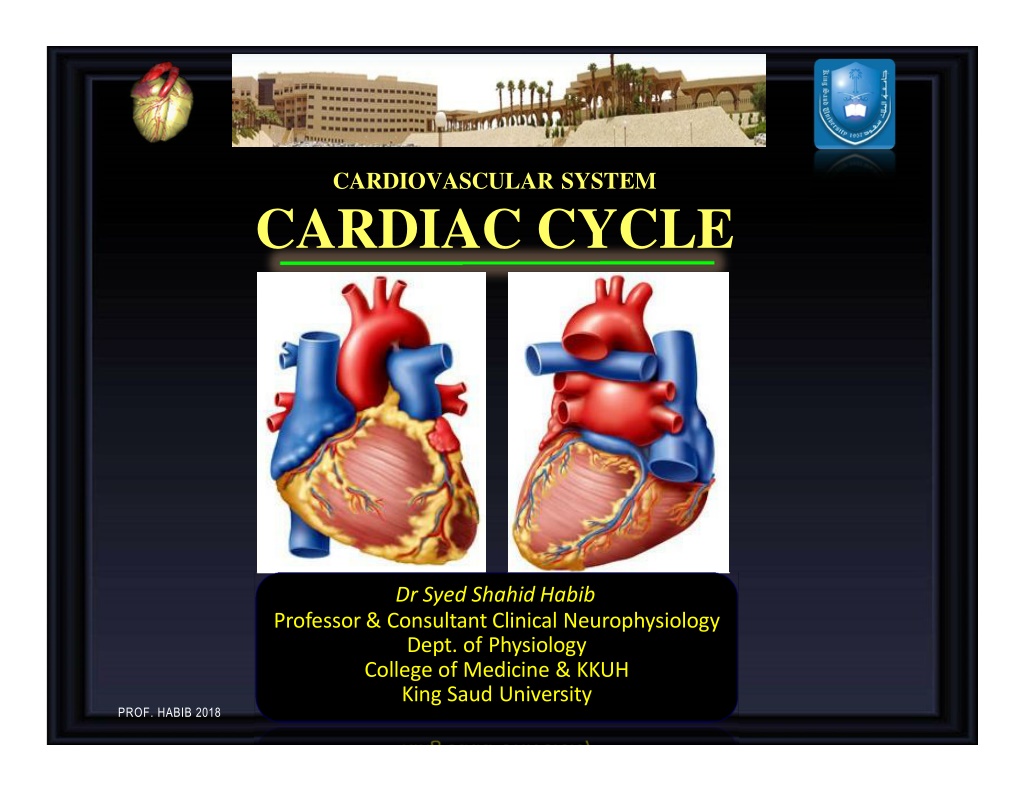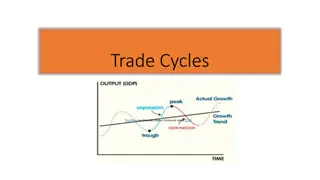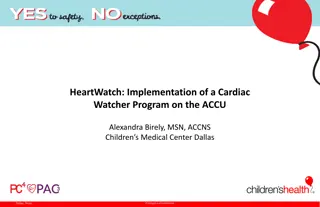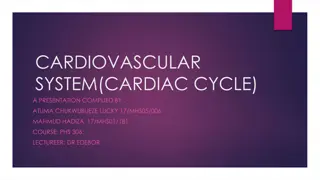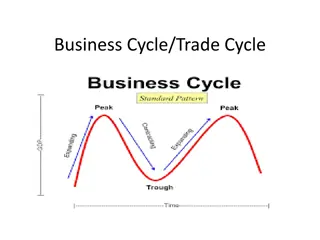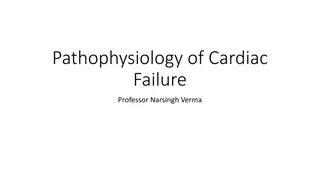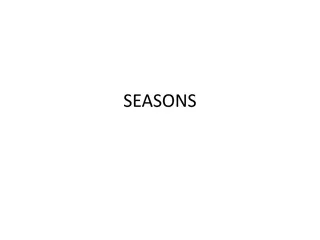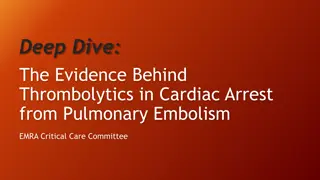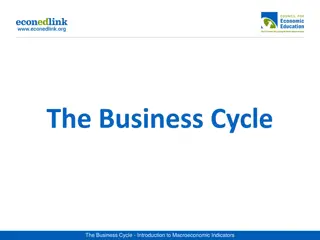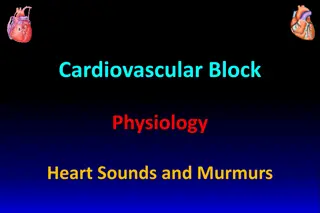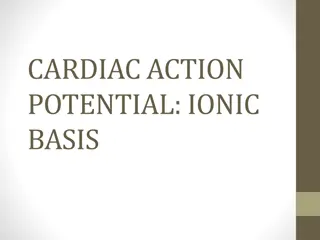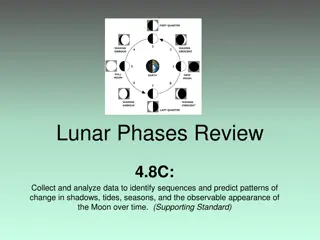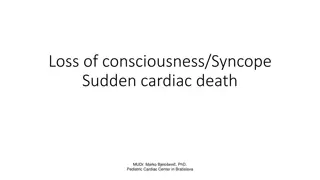Understanding the Cardiac Cycle: Phases and Events Explained
Explore the intricate workings of the cardiac cycle, from the mechanical and electrical changes to the phases in both atria and ventricles. Learn about the time duration of a cardiac cycle, the impact of heart rate on systole and diastole, and various pressure, volume, and sound changes occurring during this vital process. Delve into fascinating facts about the heart and discover its incredible capabilities.
Download Presentation

Please find below an Image/Link to download the presentation.
The content on the website is provided AS IS for your information and personal use only. It may not be sold, licensed, or shared on other websites without obtaining consent from the author. Download presentation by click this link. If you encounter any issues during the download, it is possible that the publisher has removed the file from their server.
E N D
Presentation Transcript
CARDIOVASCULAR SYSTEM CARDIAC CYCLE Dr Syed ShahidHabib Professor & Consultant Clinical Neurophysiology Dept. of Physiology College of Medicine & KKUH King Saud University PROF. HABIB 2018
OBJECTIVES At the end of the lecture you should be able to .. 1. 2. 3. Enumerate the phases of cardiac cycle Explain the effect of heart rate on duration of systole and diastole Recognize the pressure, electrical, sound and volume changes during cardiac cycle Correlate different phases of cardiac cycle with various changes in events. Compare and contrast left and right ventricular pressures and volumes during the normal cardiac cycle. Describe atrial pressure waves & their relationship to cardiac cycle Describe the use of the pressure-volume loop in describing the phases of the cardiac cycle 4. 5. 6. 7. SOURCE GUYTON 13TH ED. CHAPTER9: PAGE:113-119 PROF. HABIB 2018
FACTS ABOUT OUR HEART Size of a fist and weighing about 250 grams In lifetime beats 2,500 million times and pumps 110 million gallons of blood. Every day, your heart creates enough energy to drive a truck for 20 miles (32 km). In a lifetime, that is equivalent to driving to the moon and back Our heart has its own electrical impulse, it can continue to beat even when separated from the body, as long as it has an adequate supply of oxygen PROF. HABIB 2018
CARDIAC CYCLE Definition: Cardiac Cycle is the time duration comprising all the events from beginning of one heart contraction to the beginning of next heart contraction. At heart rate of 75 beats per minute duration of one Cardiac cycle is 0.8 second. What are the Events? PROF. HABIB 2018
EVENTS OF CARDIAC CYCLE Mechanical changes: 1.Phases of cardiac cycle 2.Heart sounds 3.Pressure changes during cardiac cycle 4.Volume changes during cardiac cycle Electrical Changes 5.Electrocardiogram (ECG) PROF. HABIB 2018
The Events of the Cardiac Cycle PROF. HABIB 2018
PHASES OF CARDIAC CYCLE Atrial Events Atrial systole: 0.1 second Atrial diastole : 0.7 seconds Ventricular Events Ventricular systole : 0.3 seconds Ventricular diastole : 0.5 seconds CARDIAC CYCLE 0.8 SECONDS PROF. HABIB 2018
ATRIAL SYSTOLE 0.1 SEC ATRIALDIASTOLE 0.7 SECONDS VENTRICULAR SYSTOLE 0.3 SECONDS VENTRICULAR DIASTOLE 0.5 SECONDS CARDIAC CYCLE 0.8 SECONDS PROF. HABIB 2018
VENTRICULAR EVENTS Ventricular systole 1.Isovolumetric contraction 2.Ejection phase Rapid ejection Slow ejection Ventricular Diastole 1. Isovolumetric relaxation phase 2. Filling phase Rapid filling Slow filling (Continued filling) Last rapid filling (Atrial Systole) PROF. HABIB 2018
PHASES OF CARDIAC CYCLE PROF. HABIB 2018
VENTRICULAR SYSTOLE (Peak of R wave of QRS complex to the end of T wave) 0.31 sec ISO-VOLUMETRIC CONTRACTION 0.06 sec MAXIMUM EJECTION (2/3, 70%) 0.11 sec REDUCED EJECTION (1/3, 30%) 0.14 sec VENTRICULAR DIASTOLE (End of T wave to the peak of R wave of QRS complex) 0.52 sec ISO-VOLUMETRIC RELAXATION 0.06 sec RAPID INFLOW 0.11 sec SLOW INFLOW / DIASTASIS 0.2 sec ATRIAL SYSTOLE (after P wave) 0.11 sec 7 Phases of CARDIACCYCLE 0.8 sec Importance of the long ventricular diastole? This is important for: Coronary blood flow & Ventricular filling PROF. HABIB 2018
VARIOUS PRESSURE VALUES CHAMBERS NORMAL RANGE (mm ofHg) Right Atrium 2 8 Right Ventricle ( systolic) 15 25 (diastolic) 2 -8 Pulmonary Artery (systolic) 15 25 (diastolic) 8 - 15 Left Atrium 2-10 Left Ventricle (systolic) 100 120 (diastolic) 2 10 PROF. HABIB 2018
End Diastolic Volume: Volume of blood in each ventricle at the end of diastole. It is about 110 120 ml. End Systolic Volume: Volume of blood in each ventricle at the end of Systole. It is about 40 to 50 ml Stroke Volume: It is a volume of blood pumped out by each ventricle per beat. It is about 70 ml. Stroke volume (SV) = EDV ESV PROF. HABIB 2018
EJECTION FRACTION (EF) is the percentage of ventricular end diastolic volume (EDV) which is ejected with each stroke. SV or (EDV ESV) EF = X100 EDV 75 X 100 = 62.5% 120 Normal ejection fraction is about 60 65%. Ejection fraction is good index of ventricular function. PROF. HABIB 2018
ATRIAL SYSTOLE Atrial Depolarization Atrial contraction Atrial pressures rise Blood flows across AV valves ATRIA = PRIMER PUMPS . Ventricular filling : 80% - direct flow from SVC & IVC 20% - atrial contraction. PROF. HABIB 2018
ISOVOLUMETRIC CONTRACTION Increase in ventricular pressure> atrial pressure AV valves close After 0.02s, semilunar valves open Period between AV valve closure and semilunar valve opening heart prepares for contraction without shortening occurs without emptying Tension develops without change in musclelength PROF. HABIB 2018
EJECTION When LV pres > 80 mm Hg RV pres > 8 mmHg, The semilunar valvesopen. Rapid Ejection 70% emptyingin first 1/3duration Slow Ejection 30% in last 2/3time The pressure in the ventriclekeeps decreasing until it becomes lower than that of the great vessels PROF. HABIB 2018
ISOVOULUMETRIC RELAXATION When ventricle pressure < arterial pressure backflow of blood forces semilunar valves to close. For 0.03-0.06 s, ventriclerelaxes despite no change in its volume AV and Semilunar valves are closed Meanwhile, atria fill up and atrial pressure graduallyrises Pressures in ventricle keep falling till it is < atrial pressure PROF. HABIB 2018
VENTRICULAR FILLING Begins with the openingof AV valves Rapid filling first 1/3of diastole (60-70%blood) Reduced filling (Diastasis) middle 1/3 ofdiastole Atrial contraction last1/3 of diastole (27-30%blood) As the atrial pressures fall, the AV valves close and left ventricular volume is now maximum EDV (120 ml in LV) PROF. HABIB 2018
Aortic Pressure Curve a.Ascending or anacroticlimb: This coincides withthe rapid ejectionphase The amount ofblood enters aorta > leaves Aortic pressure upto 120 mmHg b.Descending orcatacrotic limb: (Has 4 stages) Pulmonary artery pressure changes are similar to the aortic pressure changes but with difference in magnitude. Normal pulmonary artery pressure during the cardiac cycle 25-30/4-12 mmHg
Descending / catacrotic limb - 4STAGES 1. Aortic pressure: This coincides with the reduced ejectionphase The amount of blood enters aorta < leaves 2. Dicrotic notch (incisura): Due to closure of aortic valve There is sudden drop in aortic pressure This notch is seen in the aortic pressure curve at end of ventricular systole 3. Dicrotic wave: Due to elastic recoil of the aorta Slight in aortic pressure 4. Slow aortic press: up to 80 mmHg Due to continued flow of blood from aorta systemiccirculation PROF. HABIB 2018
Atrial pressure changes during the cardiac cycle THE JUGULAR VENOUS PULSE (JVP) PROF. HABIB 2018
Atrial pressure changes during the cardiac cycle The 3 wave (a, c, & v) are equal to ONE cardiac cycle = 0.8sec 3 upwardwaves: a, c, & v waves 2 components ineach wave: +ve ( pr), -ve ( pr) 2 downwarddeflection (waves): x & ywaves PROF. HABIB 2018
Atrial pressure waves a wave: Atrial systole: atrial pressure during atrial contraction c wave: Ventricular systole +ve as a result of bulging of AV valve into the atria during isovolumetric contraction phase -ve as a result of pulling of the atrial muscle & AV cusps down during rapid ejection phase , resulting in atrial pressure v wave: Atrial diastole or venous return (VR) +ve: atrial pressure gradually due to continuous VR -ve as a result of atrial pressure during rapid filling phase x descent: Downward displacement of AV valves during reduced ejectionphase y descent: atrial pressure during reduced filling phase PROF. HABIB 2018
CORRELATING EVENTS TOGETHER 26 PROF. HABIB 2018
ATRIAL SYSTOLE JVP a wave ECG P wave precedes the atrial systole. PR interval depolarization proceeds to the AVN. The brief pause allows complete ventricular filling Heart sounds - S 4 pathological. Vibration of the ventricular wall during atrial contraction. Heard in stiff ventricle like in hypertrophy and in elderly. Also heard in massive pulmonary embolism, cor pulmonale, TR PROF. HABIB 2018
ISOVOLUMETRIC CONTRACTION Volume does not change All valves are closed JVP c wave due to the bulging of the Tricuspid valve into RA secondary to increased pressure in theventricle. ECG End of QRS complex Heart Sounds S1 : closure of the AVvalves. PROF. HABIB 2018
EJECTION Rapid Slow JVP no waves ECG T wave Heart sounds none Aortic pressure - Rapid rise in the pressure = 120 mm Hg. Even at the end of systole pressure in the aorta is maintained at 90 mm Hg because of the elastic recoil PROF. HABIB 2018
ISOVOLUMETRIC RELAXATION Volume does not change All valves are closed JVP: v wave due to venous return to the atria from SVC and IVC ECG: End of T wave Heart sounds: S2 : closure of the semilunar valves coincides with this phase. Aortic pressure curve: INCISURA - when the aortic valve closes. Caused by a short period of backflow before the valve closes followed by sudden cessation of the backflow when the valve closes. PROF. HABIB 2018
VENTRICULAR FILLING Rapid filling Reduced filling Atrial contraction JVP y descent in first 2/3 & a wave in last1/3 ECG P wave before atrial systole Heart sounds - S3- Pathological in adults. Seen in dilated congestive heart failure, MI, MR, severe hypertension. Normal inchildren. PROF. HABIB 2018
ABNORMALITIES OF a WAVE Elevated a wave Tricuspid stenosis Decreased ventricular compliance (ventricular failure, pulmonic valve stenosis, or pulmonary hypertension) Cannon a wave Atrial-ventricular asynchrony (atria contract against a closed tricuspid valve) complete heart block, following premature ventricular contraction, during ventricular tachycardia, with ventricular pacemaker Absent a wave Atrial fibrillation or atrial standstill Atrial flutter PROF. HABIB 2018
Volume-Pressure Diagram During the Cardiac Cycle; Cardiac Work Output. PROF. HABIB 2018
BASIC MYOCARDIAL MUSCLEMECHANICS: Both ventricular systole & diastole can bedivided into early & latephases. Systole: Earlysystole= IsovolumetricContraction . Late systole= Isotonic Contraction EjectionPhase . Diastole: Early diastole = IsovolumetricRelaxation . Late diastole= IsotonicRelaxation FillingPhase . PROF. HABIB 2018
VENTRICULAR PRESSURE - VOLUMELOOP Plots LV pressureagainst LV volume through one complete cardiaccycle Systole: divided into Early systole Late systole Diastole: dividedinto Early diastole Late diastole LateDiastole (Fillingphase) PROF. HABIB 2018
VENTRICULAR PRESSURE - VOLUMELOOP Systolic BP End of Systole Diastolic BP Contractility Area = Work Compliance Beginning of Systole EDV ESV SV = EDV - ESV
b. Increased afterload refers to an increase in aortic pressure. n The ventricle must eject blood against a higher pressure, resulting in a decrease in stroke volume .is reflected in decreased width of the pressure volume loop. The decrease in stroke volume results in an increase in end-systolic volume. a. Increased preload: n refers to an increase in end-diastolic volume and is the result of increased venous return. causes an increase in stroke volume based on the Frank Starling relationship .reflected in increased widthof the pressure volume loop.
EFFECT OF ATRIAL CONTRACTION ON VENTRICLE FILLING At rest, atrial contraction adds little extra blood to the ventricles. When the heart rate is high, ventricle filling time is reduced. During exercise, atrial contraction adds a MORE amount of blood to the ventricles. PROF. HABIB 2018
Hear Rate & Cardiac Cycle At Rest After Exercise PROF. HABIB 2018
Hear Rate & Cardiac Cycle Higher the rate lesser is duration of Cardiaccycle. However, the duration of systole is much more fixed than thatof diastole. When the heart rate is increased, diastole is shortened to a much greater degree. For example, at a heart rate of 65 beats/min, the duration of diastole is 0.62 s, whereas at aheart rate of 200 beats/min, it is only 0.14s. Up to about 180/min, filling is adequate as long as there is enough venous return, and cardiac output per minute is increased by an increase in rate. However, at very high heart rates, filling may be compromised to such a degree that cardiac output per minute falls. Physiologic and clinical implications of shortened diastole: The heart muscle rests during diastole. Coronary blood flows to the subendocardial portions of the left ventricle only during diastole. Furthermore, most of the ventricular filling occurs in diastole. PROF. HABIB 2018
THANKS PROF. HABIB 2018
